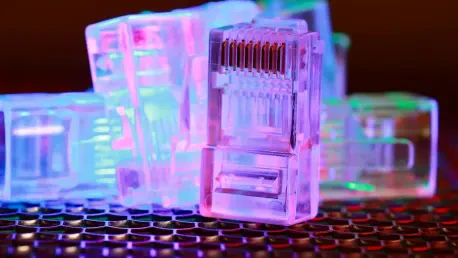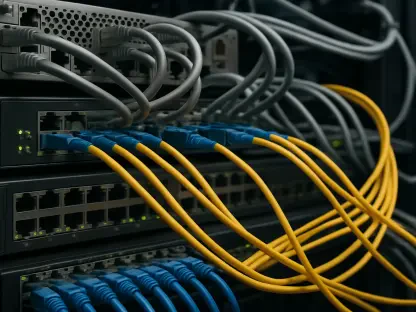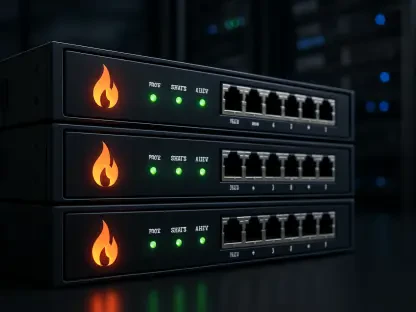The landscape of artificial intelligence (AI) is continually evolving, necessitating advancements in the networking infrastructure that underpins its complex operations. Unlike traditional networks, AI networking requires support for intensive data processing, low latency, and high bandwidth. As the AI industry’s demands shift, DriveNets’ initiative to integrate its Network Cloud solution into AI data centers represents a pivotal stride toward meeting these needs. This initiative underscores the transformation of networking paradigms, specifically highlighting the role of Ethernet alongside technologies like InfiniBand, which have traditionally catered to AI’s unique requirements.
The Growing Importance of Network Solutions in AI
Challenges in Conventional AI Networking
Traditional networking technologies often struggle to satisfy the unique requirements of AI workloads, leading to performance bottlenecks that could stymie progress. InfiniBand has been a prominent option, providing robust performance benefits for AI but burdened by vendor-specific constraints. Its implementation is hindered by limited expertise and vendor lock-in, narrowing options for companies seeking a flexible and scalable networking solution. This challenge has paved the path for Ethernet, which is preferred by many due to its ubiquity and ability to mitigate the issues of lock-in. A ZK Research study highlights this trend, showing that a significant portion of respondents favor Ethernet for its widespread use and accessibility.
However, standard Ethernet technology is not without its limitations when applied to AI operations. The demands of AI workloads—the need for lossless connectivity with extraordinarily low latency and substantial bandwidth—pose challenges for conventional Ethernet deployments. Despite its adaptability, Ethernet often falls short of delivering the precise performance metrics required by AI ecosystems. The need for Direct Path Units (DPUs) to offload networking burdens from servers further emphasizes Ethernet’s current limitations in handling AI workloads efficiently.
DriveNets’ Innovative Approach
DriveNets is tackling these challenges head-on with its Fabric Scheduled Ethernet architecture. This innovative approach uses standard Ethernet connections on the client side, paired with a sophisticated, cell-based, hardware-centric scheduled fabric system. This cutting-edge solution ensures that the network delivers lossless and predictable performance, critical attributes for facilitating efficient AI clustering. By implementing a Broadcom-based cell protocol, the solution effectively disaggregates traditional chassis switches into modular top-of-rack and fabric switches. This architectural adjustment enables horizontal scalability, allowing the network to grow flexibly as AI demand increases.
A notable feature of DriveNets’ architecture is its pioneering “cell spraying” technique. This method optimizes load balancing across various switches, ensuring traffic is evenly distributed and minimizing congestion. The approach is bolstered by virtual output queuing—a mechanism that circumvents head-of-line blocking by maintaining separate queues for each output at individual input ports. These innovations enable multi-tenant networks to function efficiently in shared infrastructure environments without traffic interference between different queues. As a result, organizations can achieve seamless data flow, crucial for the shared resource models prevalent in modern AI applications.
Benefits and Implications of DriveNets’ Solutions
Enhancing Multi-Tenant Networks
DriveNets’ technology brings numerous advantages to multi-tenant AI networks, optimizing both performance and resource management. By facilitating effective data sharing and collaboration across departmental and corporate borders, AI clusters become more efficient and collaborative. This enhancement benefits managed service providers as well, allowing them to offer improved network services. The flexibility of deployment models, such as subscriptions or as-a-service offerings, makes it easier for service providers to cater to diverse customer needs while maintaining optimal performance.
Moreover, by combining the performance strengths of InfiniBand with the straightforward deployment characteristic of Ethernet, DriveNets provides versatility unmatched by traditional solutions. This versatility is evident in the independence from specific GPUs, NICs, or DPUs, granting businesses the liberty to adapt their technology as per their evolving requirements. Customers hence receive a more scalable, flexible infrastructure that can be tailored according to their unique AI networking demands.
Facilitating Simplicity and Efficiency
Despite its advanced features, DriveNets’ solution emphasizes simplicity in its deployment and management. While not entirely plug-and-play, the setup process is designed to be intuitive, allowing users to configure AI clusters efficiently. This ease of use facilitates rapid network expansion, simply by adding more switches, which radically speeds up AI cluster implementation and leads to significant cost savings. The transition from InfiniBand to Ethernet, when assessed through this lens of simplicity and abundant expertise in Ethernet management, seems inevitable for the broader scaling of AI operations.
Such developments highlight the ongoing transformation within AI networking, as businesses increasingly require adaptable solutions that align with their strategic goals. Although InfiniBand still holds value for those capable of managing its complexities, Ethernet’s enduring appeal lies in its accessibility and comprehensive support landscape. This appeal is crucial as AI technologies continue to scale, with companies needing solutions that cater to both current and future demands efficiently.
The Future Direction of AI Networking
Evaluating Alternatives and Making Informed Decisions
The decision between InfiniBand and Ethernet is not straightforward and demands careful consideration of each organization’s specific requirements. As AI workloads continue to grow in scale and complexity, the networking solutions must adapt accordingly. Therefore, while Ethernet presents a pragmatic and scalable alternative, organizations should undertake thorough evaluations of the features and limitations of each technology. Only by aligning with these technological advancements can companies ensure sustainable growth and innovation.
The future of AI networking will likely see increased hybridization, where different technologies are integrated to capitalize on their individual strengths. In this evolving landscape, DriveNets’ solution stands as a testament to the potential of Ethernet to serve as a backbone for AI infrastructure, provided it is enhanced with the requisite architecture to meet AI’s unique demands. Consequently, stakeholders in the AI space must remain informed and agile, ready to pivot in alignment with technological advancements.
Anticipating Continued Innovation
The artificial intelligence (AI) landscape is in constant flux, driving the need for improvements in the networking infrastructure essential for its sophisticated operations. Unlike conventional networks, those tailored for AI must accommodate intense data processing demands, ensuring minimal latency and substantial bandwidth. As the needs of the AI sector evolve, DriveNets is making noteworthy advancements with its Network Cloud solution, integrating it into AI data centers to address these requirements. This move highlights a shift in networking paradigms, emphasizing the role of Ethernet alongside technologies such as InfiniBand, which have traditionally met AI’s unique needs. DriveNets’ approach signifies a major step in enhancing networking capabilities to better align with AI’s complex demands, ensuring seamless data flow and more efficient data center operations. By focusing on Ethernet technology, DriveNets seeks a middle ground between conventional infrastructures and those specially designed for high-performance AI applications.









